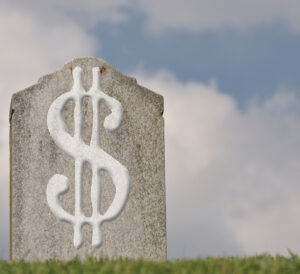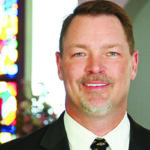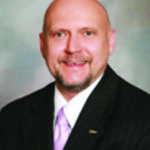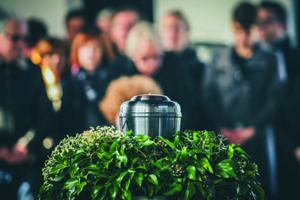The business of death
8/4/2021COVID-19, rising costs speed up changes in the funeral industry.
 One would be hard pressed to find an industry that isn’t changing with the times, and the funeral industry is no different. Cremation continues to rise in popularity. Technology, spurred by COVID-19, is increasingly integral to funerals. Services are becoming more personalized. And, perhaps the greatest change is one of attitude, illustrated by the simple fact that the “funeral” is now increasingly referred to as a “celebration of life.”
One would be hard pressed to find an industry that isn’t changing with the times, and the funeral industry is no different. Cremation continues to rise in popularity. Technology, spurred by COVID-19, is increasingly integral to funerals. Services are becoming more personalized. And, perhaps the greatest change is one of attitude, illustrated by the simple fact that the “funeral” is now increasingly referred to as a “celebration of life.”
One would be hard pressed to find an industry that isn’t changing with the times, and the funeral industry is no different. Cremation continues to rise in popularity. Technology, spurred by COVID-19, is increasingly integral to funerals. Services are becoming more personalized. And, perhaps the greatest change is one of attitude, illustrated by the simple fact that the “funeral” is now increasingly referred to as a “celebration of life.”
Cremation surpasses burial — in number, not cost
Cremation has steadily grown in popularity, until now it outnumbers burials. The National Funeral Directors Association’s (NFDA) “2020 Cremation & Burial Report” indicated that the projected burial rate for the year would be 37.5% (down 7.7% from 2015) and the projected cremation rate would be 56% (up 8.1% from 2015). The NFDA predicts that, by 2025, the burial rate will be 30.6%, and the cremation rate will be 63.3%. (https://nfda.org/news/trends-in-funeral-service)
With the rising costs of funerals, many find cremation to be a simpler and more affordable option.
“Direct cremation has no attendees and no ceremonies. This may seem a tad austere, but there’s a growing demand for unpretentious, no-frills services like these,” according to The New Economy (https://www.theneweconomy.com/business/the-funeral-industry-begins-to-bury-tradition). “It also makes financial sense: Families can save thousands by holding a personal memorial service afterwards instead of a formal ceremony in a church.”
About 80% of his clientele who choose cremation also choose to have viewing and/or services for their loved one, says Pete Eicher, funeral director, Hamilton’s Funeral Home.
Death care, according to The New Economy, is a $21 billion industry, with the average U.S. funeral costing more than $9,000.
The NFDA has calculated the median cost of a funeral with viewing and burial by totaling the costs of basic services fees, transportation of remains, preparation of the body (embalming, casketing, cosmetology, dressing etc.), a metal casket, use of facilities for viewing and funeral, memorial printing, etc. Add in the cost of a vault, required by most cemeteries, and the total tops $9,000. That total does not include cemetery plot purchase and opening, a monument or other miscellaneous costs such as flowers.
In contrast, the NFDA calculated the median cost of cremation with a funeral and viewing to be $5,150, which includes basic services fee, transportation of remains, body preparation, use of facilities for viewing and funeral, basic memorial items and cremation fee. The cost does not include a cremation casket, rental casket or cremation container; urn; or cemetery costs if the family chooses burial of the cremated remains.
While cremation has become more commonplace, the number increased further during the pandemic. More than half of funeral directors reported increases in cremation rates due to the coronavirus pandemic, according to the NFDA’s “2020 Cremation & Burial Report,” which attributed the increase to the “sheer volume of deaths.”
Cost, however, isn’t the only factor driving the increase in cremations, said Blair Overton, owner, Merle Hay Funeral Home, Brooks Funeral Care, and The Cremation Society of Iowa. Some think it is more environmentally friendly than burial while others know they are not “going back home” to where they were raised, he says. “People used to be born, raised and died close to home. People are more transient now and not going back for burial.”
Incorporating technology

Blair Overton
As with other businesses, funeral homes have been putting technology to use in promoting their business, making options and products easy to review online, and communicating with customers. Their websites provide information and a means for the public to contact them.
Technology is also impacting funeral services. Slideshows and videos of the deceased person’s life have become common.
“They are powerful and wonderful,” says Overton, adding that he sees those “growing and improving” along with technology. He is building a new funeral home and says that the technology is incorporated into the construction, with flat panel televisions and cameras in place for showing videos and recording services.
And, while livestreaming of services was around pre-COVID-19, the pandemic made it a standard option.
“Streaming was a godsend,” said Overton. “Limited people could attend services, so streaming became more important.” The link to the recording of the service is now often a part of the obituary and family and friends can keep a copy on DVD as well, he said.
Nearly half of its member funeral homes started offering livestreaming when COVID-19 shut down many public gatherings, reports the NFDA, and the organization expects this trend to continue.
While livestreaming was instrumental during the pandemic, many people “missed the personal touch,” said Eicher. “People still desire that personal contact. It’s very moving. Day to day, many forget the importance of that.” He added that livestreaming has quickly fallen to the wayside once restrictions of attendance were lifted.
The Internet has also provided additional ways to memorialize the deceased, said Overton, pointing to various platforms where people can express their condolences online. Some people have opted out of having visitations where people can share their grief in person, which he says is important to healing.
“I’m a big believer in visitation, where one can give and receive care,” says Overton, who quoted his father, “Grief shared is grief diminished.” Without a formal visitation time, those initial meetings with other people will be in public places, which can make for an awkward situation as people try to express their condolences.
Personalized touches hallmark of today’s services
Funerals have become more individualized, with a number of different ways family and friends can memorialize the deceased. From selecting favorite songs to playing slideshows and videos of the person’s life to displaying their prized possessions, visitation and services often capture highlights of the loved one’s life. Some services go even further, with themes reflecting the person’s interests and hobbies.
“As baby boomers age and find themselves having to plan funerals for loved ones and themselves, they are making funeral choices based on values that are different than previous generations,” according to the NFDA. “Baby boomers see funerals as a valuable part of the grieving process and are seeking ways to make them meaningful.
“Today, funeral service consumers are planning funeral services that are as unique as the person who died,” the NFDA continued. “The idea of making funerals personal has resulted in an explosion of unique services that reflect the hobbies, passions and interests of someone who has died. By making a funeral reflective of the life of the individual who died, the service can be more meaningful.”
One funeral had the deceased’s motorcycle at the service, said Eicher. Another, this one for a Corvette enthusiast, had the person’s Corvette in the parking lot and others drove theirs to the service. Another funeral had a baseball theme.
“The possibilities are endless” when it comes to personalizing a service as a “reflection of the person,” Eicher added.
A new meaning for funerals: a celebration of life

Pete Eicher
As with many difficult-to-discuss topics, death has its share of euphemisms, such as “passing on.” The word “funeral” is also giving way to more agreeable terms such as “celebration of life.” Overton and Eicher agree: The two terms refer to the same thing. However, the change in terminology reflects the changing nature of the funeral, with greater emphasis on sharing memories, noting accomplishments, and focusing on the deceased’s life rather than death.
“We are consciously trying to change the terminology,” says Overton. “People want to personalize the services and share how their loved ones’ lives live on — and we should celebrate that,” he said.
While some families build their services around their faith, others focus on family or what the deceased liked to do. “If it’s important to you, build around that,” Overton said.
Regardless of whether a family chooses cremation or burial, Overton and Eicher stress the importance of having a service of some kind.
Families sometimes think that they can’t have services with cremation.
“The increase comes with education and informing them of their options,” said Eicher.
“We try to let people know they can still memorialize their loved one even if they selected cremation,” said Overton, adding that families can hold visitation and viewing prior to cremation or services after cremation.
“COVID-19 reinforced for many the importance of funerals,” said Overton. Families struggled to say good-bye to loved ones. Some had relatives they could not visit near the end of their lives because they were in nursing homes or hospitals, and visiting wasn’t allowed. Then, funeral attendance was limited. “There was a void, and it was harder to heal,” he added.
a new face of the professionhttps://nfda.org/news/trends-in-funeral-service National funeral Directors Association “Funeral service has traditionally been a male-dominated profession. It also has been a ‘family’ profession, with firms being passed down from one generation to the next. Today, people who didn’t traditionally choose funeral service as a career are joining the profession and finding it very rewarding. In fact, many of today’s mortuary school graduates do not have family members working in funeral service and have decided to join the profession as a second career. There are many opportunities for people thinking about joining funeral service. “Today, more than 60% of mortuary science students in the United States are women. Many of these women have discovered and are attracted to the skills and traits needed as a funeral director, including communication skills, compassion, a desire to comfort those coping with a death, as well as organizational and event-planning skills.” ♦ |
Overton cited the need for closure and the chance to express and share grief as reasons why funerals are important. Without that, many people can struggle to move forward, he says.
Making one’s own plans
Helping families plan a funeral — generally after a death has occurred — has led funeral directors to encourage people to pre-plan their own services. While Overton and Eicher have seen different degrees of success in this area, they agree that pre-planning takes the weight off survivors during a difficult time.
“Planning funerals in advance allows individuals to plan a memorable funeral service that reflects their wishes,” according to the NFDA. “With advance planning, families today can plan celebrations of life as unique as the individual being remembered.”
Overton has seen families unable to agree on what their loved ones may have wanted. “They have received mixed messages and are not sure what to do.” Families who find that their loved one has pre-planned are relieved of the responsibility and stress and can focus on their grief, he said.
“It’s a great gift to the loved ones who survive,” said Eicher. “I deal with families who are so glad their loved one did this. They can focus on their emotions rather than the details.”
“There’s no downside to pre-planning. Don’t leave those unanswered questions,” said Overton.
The role of the funeral
“It is impossible that anything so natural, so necessary, and so universal as death, should ever have been designed by providence as an evil to mankind.” — Jonathan Swift (1667-1745) Irish-born English satirist
While death may be a difficult topic of conversation, the inevitableness of it means many of us will find ourselves in an end-of-life discussion at some point — whether we are making arrangements for a loved one or contemplating our own final wishes. While new options for the disposition of remains will develop (“green” options such as composting are gaining in popularity), while new features will be introduced to services, while technology will continue to evolve, one certainty that threads through generations of traditions is that, upon death, those who loved us will be drawn to each other for comfort. Whatever form funeral services will take, they will provide the means for us to gather, share and heal. ♦





















